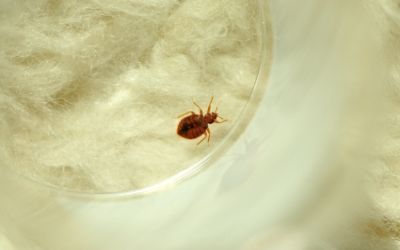Bedbugs as Vectors for Drug-Resistant Bacteria

Over the past 10 years in North America and western Europe, a resurgence of bedbugs (Cimex lectularius) has occurred. Although the basis for this resurgence is unclear, large bedbug infestations have been attributed to increased worldwide travel, altered insecticide management, and increased resistance to pesticides.
Christopher F. Lowe, of the University of Toronto in Ontario, Canada and Marc G. Romney, of St. Pauls Hospital, Providence Health Care in Vancouver, British Columbia, Canada, discuss in the most recent issue of Emerging Infectious Diseases, report on a study they conducted in an impoverished urban area of Vancouver, where bedbug infestations are increasing. The researchers say that marginalized populations in large urban centers appear to be disproportionately affected; 30 percent of shelters in Toronto, Ontario, Canada, report bedbugs. Although bedbugs have not been shown to spread disease, the researchers demonstrate that they at least carry bacteria known to cause sometimes hard-to-treat infections.
Lowe and Romney found bedbugs carrying two types of drug-resistant bacteria, methicillin-resistant Staphylococcus aureus and vancomycin-resistant Enterococci (VRE). They write, "Despite investigations of transmissibility of numerous infectious agents, including transmissible blood-borne pathogens such as HIV and hepatitis B and C viruses, to our knowledge, no conclusive evidence has demonstrated disease transmission by bedbugs. Clinically, bedbug bites have been associated with cutaneous manifestations, most commonly pruritic wheals with a central hemorrhagic punctum. Excoriation at the site of a bite can cause further skin abrasion, thereby providing an entry point for colonizing bacteria, which can potentially result in folliculitic or cellulitic superinfections. S. aureus, which is commonly found on the skin and can cause cellulitis, has been reported to colonize the salivary glands of bedbugs for as long as 15 days."
The researchers conclude, "Bedbugs carrying MRSA and/or VRE may have the potential to act as vectors for transmission. Further studies are needed to characterize the association between S. aureus and bedbugs. Bedbug carriage of MRSA, and the portal of entry provided through feeding, suggests a plausible potential mechanism for passive transmission of bacteria during a blood meal. Because of the insects ability to compromise the skin integrity of its host, and the propensity for S. aureus to invade damaged skin, bedbugs may serve to amplify MRSA infections in impoverished urban communities."
Reference: Lowe CF and Romney MG. Bedbugs as Vectors for Drug-Resistant Bacteria. Emerging Infectious Diseases. Vol. 17, No. 6. June 2011.
Â
Vet IP Roundtable 2: Infection Control and Biosecurity Challenges in Veterinary Care
March 31st 2025Veterinary IPs highlight critical gaps in cleaning protocols, training, and biosecurity, stressing the urgent need for standardized, animal-specific infection prevention practices across diverse care settings.
Invisible, Indispensable: The Vital Role of AHRQ in Infection Prevention
March 25th 2025With health care systems under strain and infection preventionists being laid off nationwide, a little-known federal agency stands as a last line of defense against preventable patient harm. Yet the Agency for Healthcare Research and Quality (AHRQ) is now facing devastating cuts—threatening decades of progress in patient safety.
From Shortages to Security: How Reusable Health Care Textiles Can Transform Infection Prevention
March 7th 2025Reusable health care textiles enhance infection prevention, reduce waste, and strengthen supply chains. Hygienically clean textiles offer a sustainable, cost-effective alternative to disposable PPE, ensuring patient safety and environmental responsibility.